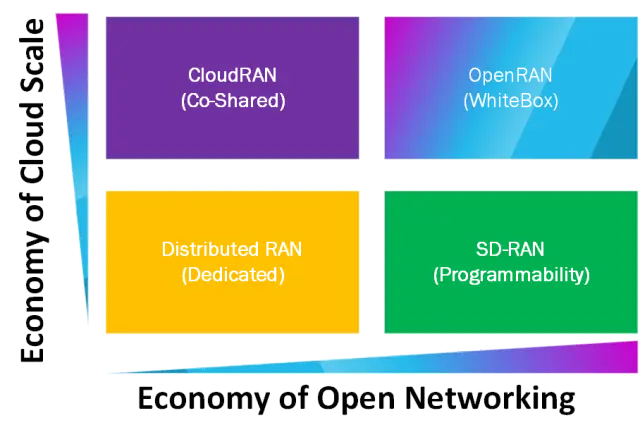4G/5G is quickly becoming the established wireless networking technology across a wide range of vertical applications, including energy, media, and transportation, as well as digital society. Many industrial enterprises opt for a private network deployment based on 4G LTE/LTE-A to serve the industrial enterprise key business drivers such as (GSMA Report)
- Guaranteed and customized network SLA and KPIs (reliability, latency, availability, etc.),
- Controlled and secured coverage, and
- Strong security and privacy.
However, 5G delivers private and dedicated networks more effectively by means of hybrid network solutions that offer flexibility of both public and private networks with varying levels of isolation, sharing, and control allowing the network services to be customized towards particular vertical industrial requirements. This, in turn, provides an economy of scale and globalization in terms of multi-x networking solution.
Multi-X: multi-vendor, multi-RAT, multi-Frequency, multi-cloud, multi-OS, and multi-deployment, and thus reducing the total cost of ownership.
Vertical Industry Networking Options enabled by 5G
The image below depicts several 5G network deployment choices, ranging from a public network to a totally standalone private network. For example, using 5G network slicing, it is possible to dedicate spectrum from a public network to create a virtualized private network to support vertical industry requirements in terms of QoS/QoE, security, and specific SLAs; or allowing an operator to sublease their spectrum to enable a third party to build and manage a private network of their own. With such rich deployment possibilities, new network roles such as Spectrum Licensee, Network Infrastructure Owner, and Virtual Network Operator become feasible. The decision on which network deployment strategy is best suited to a specific vertical sector will eventually be determined by:
- Required level of isolation, sharing and control to customize the network service;
- Trade-off between capital and operational expenditure;
- Capability of a vertical industry to operate and control a private network ;
- Compatibility and integration with the already existing infrastructure.

In addition to the flexible radio interface and network slicing capabilities, 5G networks are able to provide open networking solutions to enable vertical industries to minimize total cost of ownership through horizontal multi-vendor integration while promoting innovation through open interfaces. Vertical industries could either plug-and-play a dedicated network on-premises and interconnect with a third-party services (e.g. edge applications and services or management subsystems) using open networking, or mix-and-match different network components from different vendors to build or even deploy their custom network while exposing standardized open interfaces to allow operators to manage the network remotely. Such a solution shall be carefully designed and evaluated to guarantee the salient vertical industry requirements.
Economy of 5G
5G technology is unique in that it provides the economics of cloud scale and open networking to simplify network management, integration or migration into a unified framework, and facilitate the data processing and translation into actionable insights. Furthermore, 5G features mobility, reliability, scalability, security, low module cost, high device density, E2E application optimization, and automation, making it very appealing technology for the present and future vertical industries.

[Need to dimension your Private 5G?](mailto:contact@bubbleran.com?subject=[Private 5G]%20Request%20for%20Proposal)
